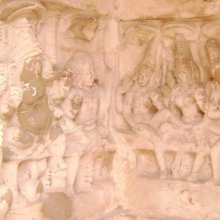Saptamatrika, Sapta-matrika, Saptamātṛka, Saptamātṛkā: 3 definitions
Introduction:
Saptamatrika means something in Hinduism, Sanskrit, the history of ancient India. If you want to know the exact meaning, history, etymology or English translation of this term then check out the descriptions on this page. Add your comment or reference to a book if you want to contribute to this summary article.
The Sanskrit terms Saptamātṛka and Saptamātṛkā can be transliterated into English as Saptamatrka or Saptamatrika, using the IAST transliteration scheme (?).
Images (photo gallery)
In Hinduism
Vastushastra (architecture)
Source: Shodhganga: Temples of Salem region Up to 1336 ADSaptamātṛka (सप्तमातृक).—The saptamātṛkas are
- Brāhmi,
- Vaiṣṇavi.
- Māheśvari,
- Kaumāri,
- Indrāṇi,
- Vārāhi
- and Cāmuṇḍā.
The concept of saptamātṛka is very old and goes back to the Puranic period. The sculptures of the saptamātṛkas begin to appear from the time of the Badami Chalukyas and continued during the successive centuries. The Nolambas being the overlords of a region of Kamataka adopted the cult of saptamātṛkas and proquered some of the best specimens of the saptamātṛka sculptures of Karnataka.
The carving of saptamātṛka sculptures is generally of two types. The first is the type where mātṛkas are carved individually. The second type consists of a row of saptamātṛkas carved on a single piece of stone. All these sculptures may be in relief or in the round.

Vastushastra (वास्तुशास्त्र, vāstuśāstra) refers to the ancient Indian science (shastra) of architecture (vastu), dealing with topics such architecture, sculpture, town-building, fort building and various other constructions. Vastu also deals with the philosophy of the architectural relation with the cosmic universe.
Purana and Itihasa (epic history)
Source: archive.org: Naisadhacarita of Sriharsa (purana)Saptamātṛkā (सप्तमातृका) refers to a set of Seven Mothers (Goddesses).—As has been pointed out by Avalon in the Introduction (p. 35) to Prapañcasāra-tantra, the Mātṛs are seven:—
- Brahmāṇī,
- Rudrāṇī,
- Kaumārī,
- Vaiṣṇavī,
- Vārāhī,
- Aindrī,
- Cāmuṇḍā or Mahābharavī.
Usually eight [viz., Aṣṭamātṛkā (eight mothers) ] are spoken of and sometimes nine; the others being Aparājitā and Nārasiṃhī.

The Purana (पुराण, purāṇas) refers to Sanskrit literature preserving ancient India’s vast cultural history, including historical legends, religious ceremonies, various arts and sciences. The eighteen mahapuranas total over 400,000 shlokas (metrical couplets) and date to at least several centuries BCE.
India history and geography
Source: Yale Journal of Music & Religion: Ritual Music in Contemporary Brahmanical Tantric Temples of KeralaSaptamātṛka refers to a group of deities worshipped in 13th century Kerala.—During this period, three rulers emerged as the most powerful: the Kōlatiri of Kōḷattunāṭu, the Sāmūtiri of Calicut (Ēṛanāṭu), and the Tiruvadi of Vēnāṭu. They worshipped fierce deities associated with warfare, such as Bhadrakālī, the Sapta Mātṛkas, Vēṭṭaykkorumakan, and Ayyappan; built new temples; and patronized priestly non-Brahmanical groups who maintained the ritual activities. Royal support facilitated the spread of the cults of these gods among warriors and other groups.

The history of India traces the identification of countries, villages, towns and other regions of India, as well as mythology, zoology, royal dynasties, rulers, tribes, local festivities and traditions and regional languages. Ancient India enjoyed religious freedom and encourages the path of Dharma, a concept common to Buddhism, Hinduism, and Jainism.
See also (Relevant definitions)
Partial matches: Matrika, Sapta.
Full-text (+15): Camunda, Sheshasamuccaya, Shrikovil, Saptamatri, Saptamata, Ayyappan, Bhadrakali, Vettaykkorumakan, Tiruvadi, Kolatiri, Samutiri, Brahmani, Mayuraksha, Carcika, Camundi, Shakri, Rudrani, Ambika, Aindri, Vajrin.
Relevant text
Search found 7 books and stories containing Saptamatrika, Saptan-matrka, Saptan-mātṛka, Sapta-matrka, Sapta-mātṛka, Saptan-matrika, Saptamatrka, Sapta-matrika, Saptamātṛka, Saptamātṛkā, Saptamatrikaa; (plurals include: Saptamatrikas, matrkas, mātṛkas, matrikas, Saptamatrkas, Saptamātṛkas, Saptamātṛkās, Saptamatrikaas). You can also click to the full overview containing English textual excerpts. Below are direct links for the most relevant articles:
Early Chola Temples (by S. R. Balasubrahmanyam)
Temples in Velachcheri < [Chapter IV - Temples of Sundara Chola’s Time]
Ashta Parivara Devatas < [Chapter XIII - Prasada: Component Parts]
Temples in Nangavaram (about the 10th year) < [Chapter X - Historical Survey]
Middle Chola Temples (by S. R. Balasubrahmanyam)
Temples in Kolar < [Chapter IV - Temples of Rajendra I’s Time]
Mahamandapa and Mukhamandapa < [Tanjavur/Thanjavur (Rajarajesvaram temple)]
Temples in Pachchil Tirumerrali < [Aditya I]
Pallava period (Social and Cultural History) (by S. Krishnamurthy)
Other Gods and Goddesses < [Chapter 3 - Socio-Religious Life]
Necklace (Hara) < [Chapter 4 - Material Culture of the People]
Conclusion (Religious Beliefs and Customs) < [Chapter 5 - Conclusion]
Temples of Munnur (Historical Study) (by R. Muthuraman)
Images of the Saptamatrikas < [Chapter 5]
Jainism in Odisha (Orissa) (by Ashis Ranjan Sahoo)
Santinatha at Ganesa Temple, Dasasvamedha Ghata < [Chapter 3: Survey of Jaina Antiquities in Odisha]
Lakulisha-Pashupata (Philosophy and Practice) (by Geetika Kaw Kher)
Rise of Tantric Elements in Lakulisa-Pasupata order < [Chapter 2 - Spread and Transition]
Related products

